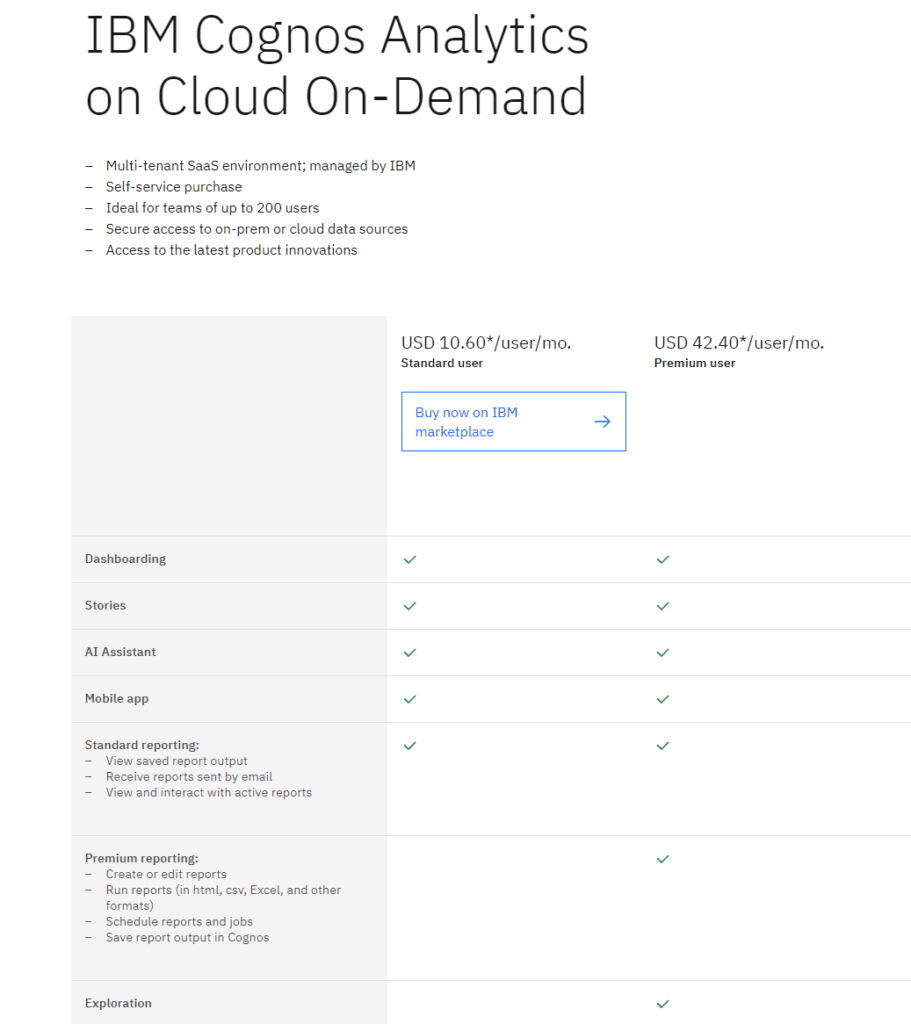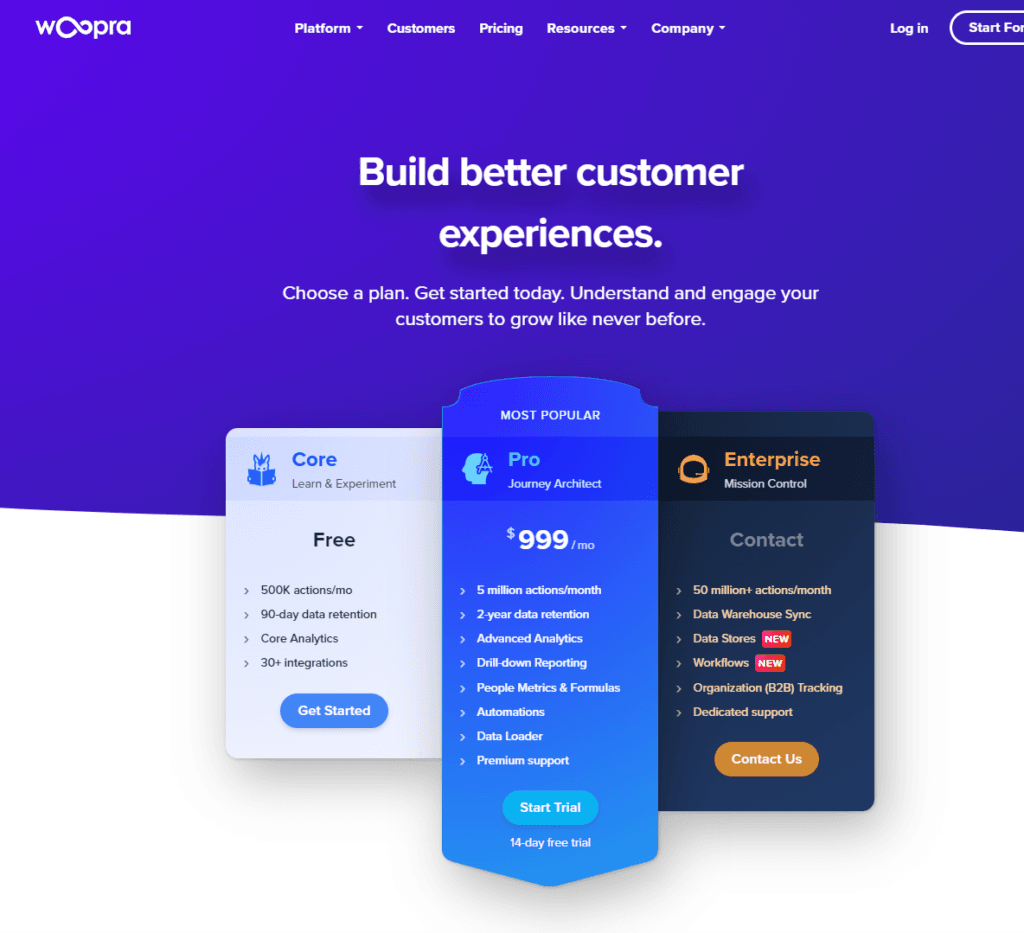When it comes to navigating the vast sea of data your business generates daily, having the right compass makes all the difference. In the realm of analytics tools, two names often surface as potential navigators: IBM Cognos Analytics and Woopra. Both are powerful, but like choosing between a sturdy ship and a swift sailboat, the decision hinges on what you’re looking to explore. Let’s dive into an in-depth comparison to help you pinpoint which tool is the perfect fit for your journey through data analysis.
| IBM Cognos Analytics | Woopra |
|---|---|
 |  |
| G2 Score – 4.0 out of 5 stars | G2 Score – 4.4 out of 5 stars |
| TrustRadius Score – 8.1/10 | TrustRadius Score – 5.8/10 |
User Interface and Experience
The Gateway to Insights: A Look Inside
Imagine walking into a room. In one corner, there’s a vast, intricate control panel, labeled IBM Cognos Analytics. It’s impressive, with dials and screens offering deep dives into data analysis. In another corner, there’s a sleek, intuitive dashboard belonging to Woopra. It’s inviting, with clear, easy-to-navigate pathways leading you to insights. This room represents the user interface (UI) and overall user experience (UX) of both tools, and it’s where our comparison begins.
IBM Cognos Analytics: A Comprehensive Dive
IBM Cognos Analytics, with its rich history in business intelligence, is like the wise sage of analytics tools. It’s robust, packed with features, and designed with the enterprise user in mind. But with great power comes a bit of complexity.
Navigating through Cognos can feel like walking through a labyrinth for newcomers. It’s not that it wants to confuse you; it’s just that it has so much to offer. The dashboard, for instance, is a cockpit of controls, graphs, and data metrics that can make your head spin at first glance. But, once you get the hang of it, it’s like flying a plane – exhilarating and efficient.
Cognos doesn’t shy away from complexity because it’s built for depth. The customization options are endless, allowing users to dive deep into data analysis. However, this means the learning curve is steep. Imagine climbing a mountain, but once you reach the top, the view (or in this case, the insights) is unparalleled.
Woopra: The Sleek and Speedy Contender
On the flip side, Woopra prides itself on being intuitive and user-friendly, designed for those who want to hit the ground running. Its interface is clean, modern, and somewhat minimalist, making it a breath of fresh air for users who may be overwhelmed by too many knobs and dials.
Woopra’s dashboard is like the dashboard of a futuristic car – everything is sleek, accessible, and designed to make your journey smooth. It offers real-time data tracking, which feels like watching the pulse of your business in real-time. For small to medium-sized businesses, or teams without dedicated data analysts, Woopra is like having a friendly guide by your side, making data analysis less daunting and more actionable.
The platform is particularly praised for its user journey analytics, providing clear visuals and easy-to-understand metrics. This focus on user experience doesn’t just apply to your customers but to you, the user of Woopra. It simplifies the complex, making data analytics a tool for all, not just the domain of data scientists.
Data Integration and Management
IBM Cognos Analytics: The Data Maestro
IBM Cognos Analytics stands out as a maestro in the symphony of data integration and management. Its capability to handle vast amounts of data from a plethora of sources is nothing short of impressive. Whether you’re pulling data from local databases, cloud storage, Excel files, or even real-time data streams, Cognos treats each source like a valued member of the orchestra, ensuring no note is missed.
One of Cognos’ standout features is its sophisticated data modeling capabilities. This allows users to transform raw data into a structured format that’s easier to analyze and understand. Think of it as sculpting a masterpiece from a block of marble; Cognos gives you the tools to chisel away the excess, revealing the beautiful statue within.
Furthermore, IBM has poured significant resources into incorporating AI and machine learning into Cognos, automating many of the tedious data preparation tasks. This not only saves time but also uncovers insights you might not have even thought to look for. It’s like having a virtual assistant who’s constantly sifting through your data, looking for gold.
Woopra: The Agile Integrator
Woopra, on the other hand, takes a more streamlined approach to data integration and management. Its focus is on providing a seamless connection to a wide array of apps and services, particularly those commonly used by digital businesses, such as CRMs, email marketing platforms, and customer support tools. This makes Woopra an agile integrator, effortlessly syncing with your existing tech stack.
What makes Woopra stand out in this arena is its commitment to providing a unified view of the customer journey. By integrating data from multiple touchpoints, Woopra helps businesses understand how users interact with their brand across various channels. This is crucial for crafting personalized experiences and targeted marketing strategies.
While Woopra might not offer the same depth of data modeling as Cognos, it excels in making data accessible and actionable for marketing and customer success teams. Its real-time analytics engine allows businesses to react quickly to customer behaviors, an invaluable asset in today’s fast-paced digital landscape.

Related: Check out our free SEO suite

Analytical Depth and Reporting Capabilities
IBM Cognos Analytics: The Deep Diver
IBM Cognos Analytics is akin to a deep-sea diver, equipped with the gear to explore the depths of data analytics. It offers a comprehensive suite of analytical tools that cater to a wide range of business needs, from ad-hoc analysis to predictive analytics. Cognos enables users to not only look at what happened in the past but also to predict future trends and model various scenarios.
The reporting capabilities of Cognos are extensive, offering everything from simple, straightforward reports to complex, multi-page boardroom quality documents. Users can customize reports to their heart’s content, ensuring that stakeholders receive tailored insights that speak directly to their needs. The ability to automate reporting processes and distribute reports across an organization further enhances its utility, ensuring that insights are shared broadly and efficiently.
Cognos also shines in its ability to handle complex data visualizations, enabling users to create interactive dashboards that can communicate complex data stories at a glance. These visualizations can be highly customized and shared across the organization, providing a powerful tool for data storytelling and decision support.
Woopra: The Agile Analyst
Woopra, in contrast, positions itself as the agile analyst, focusing on speed and efficiency without sacrificing depth. It offers a range of analytical tools designed for rapid insights, particularly around customer behavior and digital interaction. Woopra’s strength lies in its ability to track every user action across websites, apps, emails, and more, turning this data into comprehensive reports that offer a 360-degree view of the customer journey.
While Woopra might not match the predictive analytics capabilities of Cognos, it excels in real-time analytics, allowing businesses to understand and react to customer actions as they happen. This can be incredibly valuable for optimizing marketing campaigns, improving customer service, and enhancing overall user experience.
Woopra’s reporting is intuitive and user-friendly, with a strong emphasis on visual analytics. The platform allows for the creation of dynamic dashboards that update in real time, providing a constantly refreshed view of customer interactions. These dashboards are not only informative but also visually appealing, making data more accessible and engaging for a broader audience.
Scalability and Performance
IBM Cognos Analytics: Built for Enterprise Scale
IBM Cognos Analytics is designed with scalability at its core, catering to the needs of large enterprises that deal with massive datasets and a high number of concurrent users. It has the infrastructure to support growth, allowing businesses to expand their data analysis efforts without fear of hitting performance bottlenecks.
The platform’s architecture is robust, capable of handling complex data processing and analytics across multiple departments or business units. Cognos can efficiently distribute resources, ensuring that performance remains stable even as demand increases. This makes it an excellent choice for organizations that anticipate growth and require a solution that can grow with them, both in terms of data volume and complexity.
Moreover, IBM has continuously optimized Cognos for performance, implementing features like in-memory analytics and advanced caching to speed up data retrieval and report generation. These technological advancements ensure that users can access insights quickly, even as the dataset grows exponentially.
Woopra: Agile Performance for the Digital Age
Woopra, while also scalable, focuses on agility and performance tailored to the needs of digital businesses and startups. It offers a lightweight, cloud-based solution that scales easily with your business, adapting to changes in data volume and user load without requiring significant adjustments to your infrastructure.
Woopra’s performance is optimized for real-time data analytics, ensuring that businesses can track customer interactions as they happen, without delays. This real-time capability is crucial for companies that rely on timely data to make quick decisions, such as adjusting marketing campaigns or improving customer service in the moment.
The platform is designed to grow with your business, offering flexible pricing plans and a cloud infrastructure that can easily accommodate increasing amounts of data and more complex analytics needs. For startups and digital businesses, this means getting the benefits of a powerful analytics tool without the need for heavy upfront investment in IT infrastructure.
Customer Support and Community
IBM Cognos Analytics: Robust Support and an Established Community
IBM Cognos Analytics benefits from IBM’s extensive support infrastructure. Users have access to a wide range of support options, including 24/7 customer service, technical support, and a vast knowledge base of articles, tutorials, and documentation. IBM’s commitment to support ensures that Cognos users can resolve issues swiftly and receive guidance on best practices, ensuring minimal downtime and maximizing ROI on the platform.
Moreover, being a long-established player in the business intelligence and analytics field, Cognos has nurtured a large and active community. This community includes experienced data analysts, business intelligence professionals, and IT specialists. Users can tap into forums, user groups, and social media platforms to exchange insights, share solutions, and get advice from peers and experts alike. This ecosystem enriches the user experience, offering a wealth of collective knowledge and networking opportunities.
Woopra: Personalized Support and a Growing Community
Woopra, while smaller in scale compared to IBM, offers personalized customer support that is highly praised by its users. The support team is accessible, responsive, and dedicated to resolving issues promptly and effectively. Woopra’s approach to customer service emphasizes direct interaction, ensuring that users receive tailored assistance that addresses their specific concerns and needs.
In terms of community, Woopra is nurturing a growing ecosystem of users. The community includes digital marketers, product managers, and customer experience specialists, among others, who are keen on leveraging analytics to enhance digital engagement. While the community may not be as large as Cognos’s, it is active and focused, with forums, online meetups, and a presence on social media platforms where users can share insights, ask questions, and learn from each other’s experiences.
The company also provides a rich repository of resources, including tutorials, case studies, and webinars, aimed at helping users maximize their use of the platform. These resources are particularly valuable for businesses looking to leverage real-time analytics to improve customer engagement and experience.
Pricing
IBM Cognos Analytics

Woopra

Conclusion
IBM Cognos Analytics
IBM Cognos Analytics stands out as a powerhouse, designed for enterprises that demand deep analytical capabilities, extensive data integration, robust reporting features, and scalability. It offers a comprehensive suite for those who need to navigate complex data landscapes, providing powerful data modeling, predictive analytics, and automation features. Coupled with IBM’s extensive customer support network and a vast, knowledgeable community, Cognos is well-suited for large organizations looking for a scalable, enterprise-grade analytics solution.
Woopra
Woopra, on the other hand, appeals to businesses focused on real-time analytics, particularly in the context of customer behavior and digital interactions. Its strengths lie in its user-friendly interface, agility, and the ability to provide immediate insights into customer actions. This makes Woopra an excellent choice for startups, digital businesses, and those prioritizing customer experience and engagement. Additionally, its personalized customer support and growing, focused community offer valuable resources for users aiming to leverage analytics for strategic advantage in the digital arena.
Read Next:
- The Power of Testimonials and Reviews in Content Marketing
- Niche Content Marketing: Targeting Specific Audiences for Maximum Impact
- The Intersection of Content Marketing and Public Relations
- Content Curation: Adding Value by Showcasing Others’ Expertise
- 31+ Top Social Media Management tools Compared! (2023)






















Comments are closed.